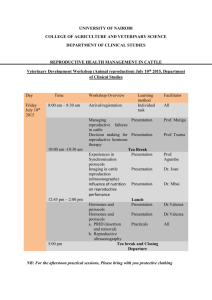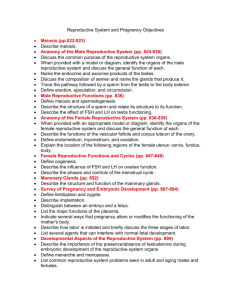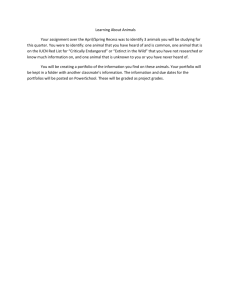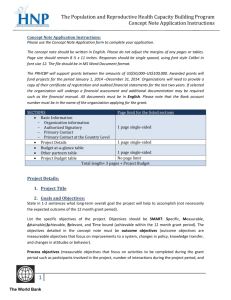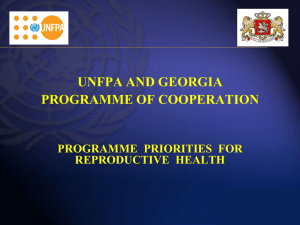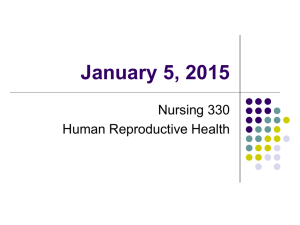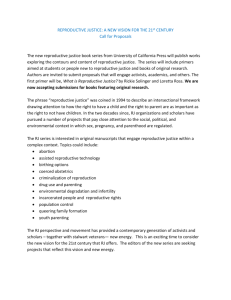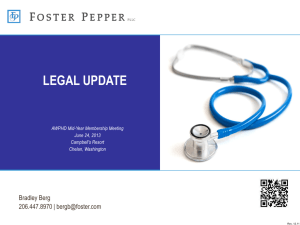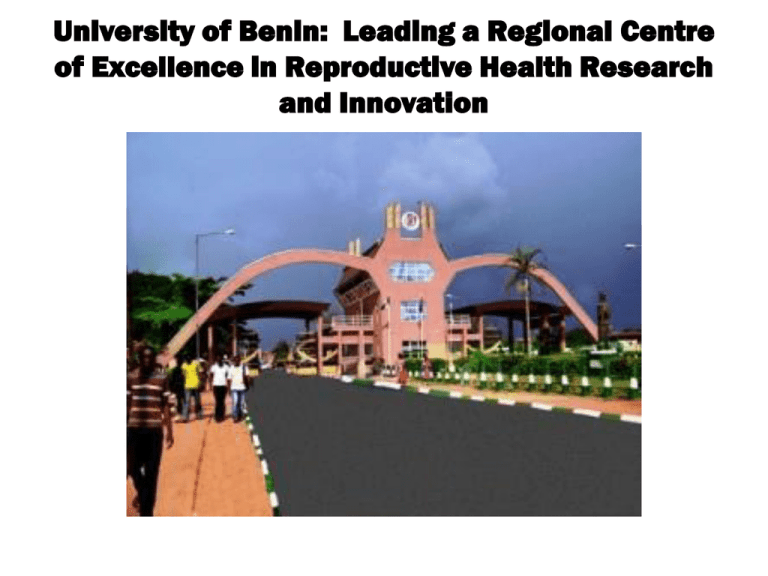
University of Benin: Leading a Regional Centre
of Excellence in Reproductive Health Research
and Innovation
Presentation Format
•
•
•
•
•
•
•
Development Challenge addressed by ACE
Academic and Research Programs
Regional Student Plan
Industry/Sector Partnership
Sustainable Financing Plan
Implementation Arrangements
Procurement Arrangements
West Africa: A Region with Contradictions
• High population growth
with huge youth budge
• Rich mineral resource,
with
high
economic
growth rate
• Yet high rates of poverty
and underdevelopment
• Political instability, climate
change and rising sectarian
tension pose great threats
to the region
Comparative Health Indicators Between
WA Countries and Sweden
Indicator
Nigeria Ghana
Sweden
Population
2.8
Growth Rate %
Fertility Rate
5.5
2.2
0.7
4.1
1.9
Contraceptive
Prevalence
Rate
Maternal
mortality rate
10.5
23.5
78
630
350
4.0
Neonatal
mortality rate
48
28
2.0
Poor Health Indicators: A developmental
challenge in WA
• The WHO has estimated that it would take Nigeria up
to 150 years to reach the same level of health indicators
with those ofWestern countries.
• The relevant question is: How can West Africa
accelerate the pace of change to ensure that they reach
this goal sooner than later?
• The answer lies in fostering and integrating the
reproductive health approach to overall development
Definition of Reproductive Health
• A state of complete physical,
mental and social well-being
and not merely the absence
of disease or infirmity of the
reproductive system –WHO
• The
Constellation
of
methods, techniques and
services that contribute to
RH and well-being.
It
includes
sexual
health,
designed to enhance the
quality of life and personal
relations: ICPD POA, 1994
Components of Reproductive Health (1)
• Family
Planning
counselling, information,
education, communication and services
• Prevention and management of infertility
• Safe motherhood, including the prevention of
perinatal, infant and under-five deaths
• Prevention and management of unsafe abortion and
its consequences
Components of Reproductive Health (2)
• Prevention and treatment of reproductive tract
infections, including STIs and HIV/AIDS
• Prevention and management of gender-based
violence, including female genital cutting, and
human sex trafficking
• Management and prevention of genital tract cancers
• Information and research on human sexuality,
reproductive health and responsible parenthood
RH: Decades of Slow Progress in Africa
• Unfortunately, slow progress was made in many
countries between 1994 and 2014 in the adoption
and uptake of these principles
• Africa still has the highest rates of adverse
reproductive health outcomes – high fertility rates,
high rates of HIV, and gender-based violence
• These are contributing to the region’s underdevelopment and poor human development indices.
Why has RH been slow to take
effect in Africa?
• Poor integration of RH into regional developmental
agenda
• Low capacity to carry out RH interventions
• Poor country ownership, with RH agenda driven by
international interests
• Limited understanding of RH and the lack of
political will to make effective policies and take
decided actions
Post-ICPD Sustainable Development
Agenda
• Country ownership in RH
policies and programming
• Strengthening the capacity of
countries to carry out
research and innovation in
RH that address their specific
needs
• Building and sustaining RH
leaderships
• Building
political
commitments to address RH
Centre of Excellence in RH Research and
Innovation (CEHRI): Program Goals
• To act as a training hub for
the next generation of
leaders in RH inWest Africa.
• To stimulate indigenous
research and innovation in
RH needed to drive policies
and programs in the region
• To mobilize local, regional
and international support for
improving RH inWA
CERHI’s Key Strategic Objectives
• Improve regional capacity to deliver high quality training in
RH
• Increase capacity to carry out applied research in RH in the
region
• Build and use industry/sector partnerships to enhance
impact of the Center on social development
• Strengthen regional and international academic partnerships
to raise quality of RH education in other institutions in the
region.
• Enhance governance and management to support the
integration and implementation of the program.
Four Key Activities of CERHI
• Develop improved governance infrastructure (including
fund raising and financial governance) for project
sustainability
• Review and development of curricular for short
courses, bachelors, MSc and PhD in 9 different courses
across 6WA partner institutions
• Improve teaching and learning facilities and related
capacity building in RH courses;
• Purchase and improve capacity for basic, operations,
intervention and translational research in RH
CERHI Departments and Courses
Courses
Short term
courses
BSc, MBBS
MSc , M.Phil
or MPH
PhD/MD/Post
-Doc
Medicine
Yes
Yes
-
Fellows and MDs
Public Health
Yes
-
Yes
Yes
Reprod Health
Yes
Yes
Yes
Yes
Nursing
Yes
Yes
Yes
Yes
RH Physiology
-
Yes
Yes
Yes
Med Biochem
-
Yes
Yes
Yes
Reprod. Anatomy -
Yes
Yes
Yes
Medical Lab Scs
Yes
Yes
Yes
Yes
Med Sociology
Yes
-
Yes
Yes
Hlth Economics
Yes
-
Yes
Yes
Reprod Hlth Law Yes
-
Yes
Yes
Plan for attracting Regional Students
and Faculties
• Strategic communication of
CERHI’s activities
• Interactive online platform
available on admission of
students and scholars
• Scholarships to support the
admission of students
• Establishment of International
Students hostel & intl Scholars
Residential Area
• Provision of bilingual facilities
CERHI’S Academic Partners
•
•
•
•
•
•
Regional
University of Benin
University of Ibadan
Ahmadu Bello University
University of Ghana
Nigerian Institute for Medical Research
University of Benin, Cotonou
CERHI’s Academic Partners
•
•
•
•
•
•
International
University of Aberdeen
Harvard School of Public Health
University of California, Berkeley
University of Ottawa, Canada
Royal College of Obstetricians and Gynaecologists
World Health Organization
Collaborating Sector Planners
• Ministries of Health, Education, Women Affairs and
Finance
• National Universities Commission
• National Planning Commission, National Bureau of
Statistics and National Population Commission
• International and Local Development Organizations
(e.g. UN organizations, bilaterals and multilaterals,
Foundations, Dangote,TY Danjuma, etc)
• Industry – e.g. General Electric
• Civil Society Organizations
4 Activities for Externally Sustained
Funding
• Resource
mobilization
Committee
• Friends of CERHI Fund
• Funding Mobilization from
Alumni
• Capacity building of staff
and PG students in Grant
Proposal writing and
research fund-raising
4 Activities for Achieving the Quality
Benchmarks (DLI)
• M&E committee and training
of Desk officer
• Key officials to follow up on
the implementation of the
DLIs
• ICT platforms to drive the
implementation
and
achievement of the DLIs
• Collaborative ownership of
the project by partner
institutions, with continuous
feedback provided
Key selected Disbursement
Linked Indicators (selected DLIs)
Selected DLI
New/revised
RH Courses
# Partnership
Agreements
New PhDs
New Masters
New Short courses
# of published
Articles
External Revenue
Baseline- 2013
0
Projected for 2017
34
0
20
18
104
0
20
270
510
1,200
80
0
$8.0 Million
3 Success Factors/Innovative Features of
CERHI
• It’s focus on RH and
integration into development
– a neglected field inWA
• It’s potential to leverage
funds from diverse local and
international sources
• It’s multi-disciplinary focus,
enabling it to build high level
collaboration
and
partnerships, for achieving
ground-breaking discoveries
CEHRI Core Values and Principles
• Collaborative Partnership
and Joint Project
Ownership
• Transparency and
Accountability
• “Can Do Spirit” as
epitomized by timely
results reporting
• Forward-looking
commitment


